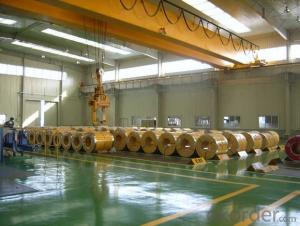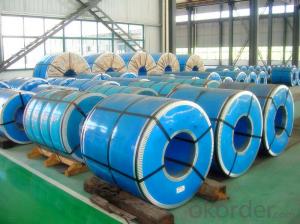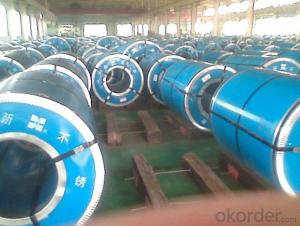Hot Rolled Stainless Steel Coil 304 No.1 Finish Narrow Strip
OKorder Service Pledge
OKorder Financial Service
You Might Also Like
Type | Hot Rolled Stainless Steel Coil 304 Narrow Strip |
Thickness | 2.5mm-4.0mm |
Width | 550mm, 650mm |
Length | according to weight |
Brand name | CNBM |
Standard | ASTM, AISI, DIN, GB, JIS etc |
Material | 304 |
Application | Foodstuff, Gas, metallurgy, biology, electron, chemical, petroleum, boiler, nuclear energy, Medical equipment, fertilizer etc |
Package | Standard export sea-worthy packing |
Delivery time | Within 15 days since getting the deposit or LC origin |
Surface | NO.1 |
Productivity | 20000 tons/month |
Hot Rolled Stainless Steel Coil 304 Chemical Composition:
(%):C=0.07, Mn=2.00, P=0.045, S=0.030, Si=0.075, Cr=17.5-19.5, Ni=8.0-10.5, N=0.10
Hot Rolled Stainless Steel Coil 304 Physical Properties
Tensile strength σb (MPa) ≥ 520
The conditions yield strength σ0.2 (MPa) ≥ 205,
Elongation δ5 (%) ≥ 40
Reduction of ψ (%) ≥ 50,
Hardness: ≤ 187
HB; ≤ 90
HRB; ≤ 200H
- Q:What are the recommended protective measures for transporting 111 stainless steel strips?
- The recommended protective measures for transporting 111 stainless steel strips include using appropriate packaging materials such as wooden crates or metal containers to prevent damage and ensure stability during transit. It is also advisable to use padding or cushioning materials, such as foam or bubble wrap, to protect the strips from scratches or dents. Additionally, securing the packages with strong straps or bands can help prevent movement and further reduce the risk of damage.
- Q:What is the corrosion resistance of stainless steel strips in different environments?
- Stainless steel strips exhibit an exceptional ability to resist corrosion in diverse environments due to the presence of a protective layer known as chromium oxide on the steel's surface. This layer forms naturally when the steel is exposed to oxygen and acts as a passive barrier, preventing further corrosion. In outdoor settings, stainless steel strips demonstrate high resistance to corrosion in atmospheric conditions. They can endure exposure to moisture, rain, and even saltwater without significant deterioration. Consequently, stainless steel is an excellent choice for marine environments and coastal areas where corrosion is a prevalent concern. Additionally, stainless steel strips possess outstanding resistance to various chemicals and acids. They can withstand exposure to a wide range of organic and inorganic compounds, making them suitable for use in corrosive environments such as chemical processing plants and pharmaceutical industries. However, it is crucial to note that certain concentrations or combinations of chemicals can still cause corrosion in stainless steel. Therefore, selecting the appropriate grade of stainless steel for specific applications is essential. The corrosion resistance of stainless steel strips can vary depending on the specific alloy and surface finish. For example, austenitic stainless steels like grades 304 and 316 offer excellent corrosion resistance in most environments, including acidic and alkaline conditions. On the other hand, ferritic and martensitic stainless steels may have slightly lower corrosion resistance but can still perform well in non-corrosive or mildly corrosive environments. In conclusion, stainless steel strips possess remarkable corrosion resistance in a wide variety of environments. Their ability to resist corrosion makes them highly versatile and suitable for diverse applications, such as construction, automotive, and food processing. However, it is crucial to consider the specific conditions and requirements of the environment when selecting the appropriate grade and finish of stainless steel to ensure optimal corrosion resistance.
- Q:What are the different types of edges available for stainless steel strips?
- The desired appearance and specific application determine the available types of edges for stainless steel strips. Examples of common edge types include: 1. Mill Edge: This straight and smooth finish is the standard produced during manufacturing, with no further processing or treatment. 2. Slit Edge: Achieved by cutting the strip to the desired width using a slitting machine, this edge may have a slight burr or roughness that can be eliminated through deburring or other finishing methods. 3. Rounded Edge: Also called a round or rolled edge, it involves rolling the strip to create a curved or rounded profile. This type of edge provides a safer and more comfortable surface, suitable for applications where sharp edges may be hazardous. 4. Deburred Edge: By removing burrs or roughness from the strip's edge, a smooth and clean finish is achieved. Deburring is typically done using specialized equipment or processes. 5. Beveled Edge: This edge is created by cutting the strip at an angle, usually 45 degrees, resulting in a sloping or chamfered edge. Beveled edges are often used for aesthetic purposes or to facilitate welding or joining of the strips. 6. Custom Edges: Custom edges can also be created to meet specific functional or aesthetic requirements of a project or application. These may include different profiles, finishes, or treatments. When selecting the appropriate edge type, it is crucial to consider the intended use and requirements of the stainless steel strips. The edge choice can impact the final product's performance, appearance, and safety.
- Q:Can stainless steel strips be used in medical implants?
- Yes, stainless steel strips can be used in medical implants. Stainless steel is a common material used in the medical industry due to its excellent corrosion resistance, durability, and biocompatibility. It is often used in the production of surgical instruments, orthopedic implants, and other medical devices. Stainless steel strips can be fabricated into various shapes and sizes to meet the specific requirements of different medical implants. The material's corrosion resistance ensures that it can withstand exposure to bodily fluids and other harsh environments within the human body, reducing the risk of implant failure or infection. Additionally, stainless steel has been extensively researched and documented for its biocompatibility, meaning it is well-tolerated by the human body and does not cause adverse reactions. This makes stainless steel a safe and reliable choice for medical implants, as it minimizes the risk of allergic reactions or long-term complications. However, it is important to note that the selection of materials for medical implants ultimately depends on the specific application and the patient's unique needs. Consultation with medical professionals and adherence to regulatory guidelines is crucial in determining the most suitable material for each individual case.
- Q:Can stainless steel strips be used in power generation industries?
- Certainly! Stainless steel strips have a wide range of applications in the power generation sector. This alloy is known for its impressive resistance to corrosion and ability to withstand harsh conditions, making it a suitable material for various purposes. In power plants, stainless steel strips find their use in the construction of equipment like turbines, generators, and other components that are exposed to high temperatures, pressure, and corrosive environments. The corrosion-resistant properties of stainless steel ensure that these components remain intact and structurally sound over time. Moreover, stainless steel strips can be utilized in the fabrication of heat exchangers, condensers, and different piping systems within power plants. The excellent thermal conductivity of stainless steel allows for efficient heat transfer, making it an ideal choice for these applications. Furthermore, stainless steel's resistance to oxidation and scaling at high temperatures makes it ideal for use in boilers and steam generators, which are essential components of power generation systems. All in all, stainless steel strips offer numerous advantages, including corrosion resistance, durability, and high-temperature performance, making them a reliable option for the power generation industry.
- Q:Are stainless steel strips resistant to acetic acid?
- Yes, stainless steel strips are generally resistant to acetic acid.
- Q:Can stainless steel strips be used in the chemical processing industry?
- Yes, stainless steel strips can be used in the chemical processing industry. Stainless steel is highly resistant to corrosion, making it suitable for handling various chemicals and acids. Additionally, stainless steel's strength, durability, and heat resistance make it an ideal material for applications in the chemical processing industry.
- Q:Can 111 stainless steel strips be formed into wire for various applications?
- Yes, 111 stainless steel strips can be formed into wire for various applications. Stainless steel is known for its excellent formability and ductility, making it suitable for wire production. The strips can be processed through a series of manufacturing techniques such as drawing, annealing, and cold rolling to transform them into wire. The resulting stainless steel wire can then be used in a wide range of applications including electrical wiring, springs, fasteners, welding electrodes, and mesh.
- Q:Can stainless steel strips be used in electronics applications?
- Yes, stainless steel strips can be used in electronics applications. They are often used for shielding against electromagnetic interference and for thermal management due to their high electrical conductivity and heat resistance properties.
- Q:How do stainless steel strips perform in cryogenic environments?
- Stainless steel strips perform well in cryogenic environments as they exhibit excellent resistance to low temperatures, maintaining their strength, toughness, and corrosion resistance.
1. Manufacturer Overview |
|
|---|---|
| Location | |
| Year Established | |
| Annual Output Value | |
| Main Markets | |
| Company Certifications | |
2. Manufacturer Certificates |
|
|---|---|
| a) Certification Name | |
| Range | |
| Reference | |
| Validity Period | |
3. Manufacturer Capability |
|
|---|---|
| a)Trade Capacity | |
| Nearest Port | |
| Export Percentage | |
| No.of Employees in Trade Department | |
| Language Spoken: | |
| b)Factory Information | |
| Factory Size: | |
| No. of Production Lines | |
| Contract Manufacturing | |
| Product Price Range | |
Send your message to us
Hot Rolled Stainless Steel Coil 304 No.1 Finish Narrow Strip
OKorder Service Pledge
OKorder Financial Service
Similar products
New products
Hot products
Hot Searches
Related keywords






























